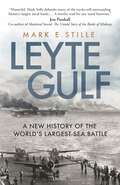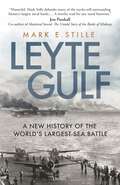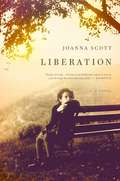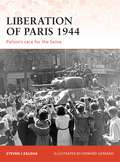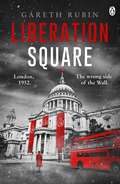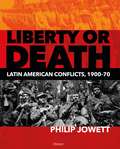- Table View
- List View
Leyte 1944: Return to the Philippines (Campaign)
by Clayton Chun Giuseppe RavaThe loss of the Philippines in 1942 was the worst defeat in American military history. General Douglas MacArthur, the 'Lion of Luzon', was evacuated by order of the President just before the fall, but he vowed to return, and in August 1944 he kept his word when he led what, at the time, was the largest amphibious assault of the Pacific War on the island of Leyte. This is the full story of that fateful battle, one of the most ferocious campaigns of World War II and one of huge strategic and symbolic significance. In the face of stubborn Japanese resistance, including the first systematic use of Kamikaze attacks, the US forces ground slowly forwards before another amphibious assault took the vital position of Ormoc in the last decisive battle of the campaign. Based on extensive research in the US Army's Military History Institute, along with other archival and veteran sources, this important study sheds new light on the operation that saw the US finally return to the Philippines and in doing so placed another nail firmly in the coffin of the Japanese Empire.
Leyte 1944: Return to the Philippines (Campaign)
by Clayton Chun Giuseppe RavaThe loss of the Philippines in 1942 was the worst defeat in American military history. General Douglas MacArthur, the 'Lion of Luzon', was evacuated by order of the President just before the fall, but he vowed to return, and in August 1944 he kept his word when he led what, at the time, was the largest amphibious assault of the Pacific War on the island of Leyte. This is the full story of that fateful battle, one of the most ferocious campaigns of World War II and one of huge strategic and symbolic significance. In the face of stubborn Japanese resistance, including the first systematic use of Kamikaze attacks, the US forces ground slowly forwards before another amphibious assault took the vital position of Ormoc in the last decisive battle of the campaign. Based on extensive research in the US Army's Military History Institute, along with other archival and veteran sources, this important study sheds new light on the operation that saw the US finally return to the Philippines and in doing so placed another nail firmly in the coffin of the Japanese Empire.
Leyte Gulf: A New History of the World's Largest Sea Battle
by Mark StilleA fascinating re-examination of the battle of Leyte Gulf, the largest naval encounter in history and probably the most decisive naval battle of the entire Pacific War, and one that saw the Imperial Japanese Navy eliminated as an effective fighting force and forced to resort to suicide tactics.Leyte was a huge and complex action, actually consisting of four major battles, each of which are broken down in detail in this book, using original sources. The plans of both sides, and how they dictated the events that followed, are also examined critically.So much of the accepted wisdom of the battle has developed from the many myths that surround it, myths that have become more firmly established over time. In this new study, Pacific War expert Mark Stille examines the key aspects of this complex battle with new and insightful analysis and dismantles the myths surrounding the respective actions and overall performances of the two most important commanders in the battle, and the “lost victory” of the Japanese advance into Leyte Gulf that never happened.
Leyte Gulf: A New History of the World's Largest Sea Battle
by Mark StilleA fascinating re-examination of the battle of Leyte Gulf, the largest naval encounter in history and probably the most decisive naval battle of the entire Pacific War, and one that saw the Imperial Japanese Navy eliminated as an effective fighting force and forced to resort to suicide tactics.Leyte was a huge and complex action, actually consisting of four major battles, each of which are broken down in detail in this book, using original sources. The plans of both sides, and how they dictated the events that followed, are also examined critically.So much of the accepted wisdom of the battle has developed from the many myths that surround it, myths that have become more firmly established over time. In this new study, Pacific War expert Mark Stille examines the key aspects of this complex battle with new and insightful analysis and dismantles the myths surrounding the respective actions and overall performances of the two most important commanders in the battle, and the “lost victory” of the Japanese advance into Leyte Gulf that never happened.
Leyte Gulf 1944: The Battles of the Sibuyan Sea and Samar (Campaign)
by Mark StilleIn October 1944, the US prepared to invade the Philippines to cut Japan off from its resource areas in Southeast Asia. The Japanese correctly predicted this, and prepared a complex operation to use the remaining strength of its navy to defend its possessions. This is the first in a two-part study of the October 23-26 Battle of Leyte Gulf, which resulted in a decisive defeat for the Japanese.In the Battle of Leyte Gulf, the Imperial Japanese Navy's First Diversion Strike Force took part in two major actions during the course of the battle: the intense air attacks from US Navy carriers on October 24 (the Battle of the Sibuyan Sea, which accounted for superbattleship Musashi), and the compelling action off Samar the following day. This book examines in detail why, following the Samar action, the Imperial Japanese Navy commander of the First Diversion Strike Force (Takeo Kurita) chose to ignore orders and break off the attack into Leyte Gulf-one of the two most controversial decisions of the entire battle. It also covers the Japanese planning for Leyte Gulf, and the strengths and weaknesses of the Imperial Japanese Navy in this phase of the war alongside the US Navy's planning and command arrangements.
Leyte Gulf 1944: Surigao Strait and Cape Engaño (Campaign)
by Mark StilleThis is the second volume in a two-part illustrated study of the October 23-26 Battle of Leyte Gulf, which resulted in a decisive defeat for the Japanese.The Battle of Leyte Gulf-the largest naval battle in history-comprised four major actions conducted over the course of two days, plus several associated minor clashes. The size and complexity of this epic battle remains unmatched, with two United States Navy (USN) fleets (Third and Seventh) facing a much-reduced Imperial Japanese Navy (IJN), severely outnumbered and fatally lacking in airpower. Complementing the first volume's coverage of the IJN's First Diversion Attack Force at the battles of the Sibuyan Sea and off Samar, this superbly illustrated second volume focuses on the forces supporting the main Japanese thrust. Naval expert Mark Stille reveals how the Japanese Main Body succeeded in its mission of luring the US Third Fleet to the north, but at a tremendous cost in the ensuing Battle off Cape Engaño. Also explored in full visual detail is the fate of the small detachment of seven IJN ships ordered to attack into Leyte Gulf through Surigao Strait in the south. The resulting Battle of Surigao Strait on October 25, 1944 would prove to be the last battleship duel in history.
Leyte Gulf 1944: Surigao Strait and Cape Engaño (Campaign)
by Mark StilleThis is the second volume in a two-part illustrated study of the October 23-26 Battle of Leyte Gulf, which resulted in a decisive defeat for the Japanese.The Battle of Leyte Gulf-the largest naval battle in history-comprised four major actions conducted over the course of two days, plus several associated minor clashes. The size and complexity of this epic battle remains unmatched, with two United States Navy (USN) fleets (Third and Seventh) facing a much-reduced Imperial Japanese Navy (IJN), severely outnumbered and fatally lacking in airpower. Complementing the first volume's coverage of the IJN's First Diversion Attack Force at the battles of the Sibuyan Sea and off Samar, this superbly illustrated second volume focuses on the forces supporting the main Japanese thrust. Naval expert Mark Stille reveals how the Japanese Main Body succeeded in its mission of luring the US Third Fleet to the north, but at a tremendous cost in the ensuing Battle off Cape Engaño. Also explored in full visual detail is the fate of the small detachment of seven IJN ships ordered to attack into Leyte Gulf through Surigao Strait in the south. The resulting Battle of Surigao Strait on October 25, 1944 would prove to be the last battleship duel in history.
Leyte Gulf 1944: The Battles of the Sibuyan Sea and Samar (Campaign)
by Mark StilleIn October 1944, the US prepared to invade the Philippines to cut Japan off from its resource areas in Southeast Asia. The Japanese correctly predicted this, and prepared a complex operation to use the remaining strength of its navy to defend its possessions. This is the first in a two-part study of the October 23-26 Battle of Leyte Gulf, which resulted in a decisive defeat for the Japanese.In the Battle of Leyte Gulf, the Imperial Japanese Navy's First Diversion Strike Force took part in two major actions during the course of the battle: the intense air attacks from US Navy carriers on October 24 (the Battle of the Sibuyan Sea, which accounted for superbattleship Musashi), and the compelling action off Samar the following day. This book examines in detail why, following the Samar action, the Imperial Japanese Navy commander of the First Diversion Strike Force (Takeo Kurita) chose to ignore orders and break off the attack into Leyte Gulf-one of the two most controversial decisions of the entire battle. It also covers the Japanese planning for Leyte Gulf, and the strengths and weaknesses of the Imperial Japanese Navy in this phase of the war alongside the US Navy's planning and command arrangements.
The Liar: A gripping story of dangerous obsession
by Jennifer WellsCan you really trust what you see? 'Eerie and intriguing. I can't believe it's a first novel' Fern Britton, Bestselling Author and TV Presenter. 1935. A mother's journey to find out what really happened to her only daughter. Complex and intriguing, full of twists and turns. Perfect for the fans of Lesley Pearse and Dilly Court. What would you do if you saw a girl in a crowd whose face had the same, identical birthmark as your only child? A child who, nearly ten years ago, you were told died? It's 1935 and housewife Emma glimpses a face in a crowd – a little girl with a very unique birthmark. Transfixed by the sight of a stranger; Emma becomes convinced that the girl is her long-lost daughter taken from her at birth. There is only one problem: Emma's daughter is dead. So who is the stranger? The Liar follows Emma's journey as she tries to find out what really happened to her daughter – a journey that unearths secrets from the past and ends in obsession... 'An intriguing mystery that keeps you guessing... If you like compelling mysteries you will love this well written story' Rosie Clarke. What people are saying about THE LIAR: 'This is well worthy of 5 stars. I highly recommend this book' 'I was gutted when I got to the end because I wanted to keep reading!' 'A compelling and well written novel' 'It's so unexpected, with twists and turns that were both shocking and exciting'
The Liar’s Key (Red Queen’s War #2)
by Mark LawrenceFrom the critically-acclaimed author of PRINCE OF FOOLS comes the second volume of the brilliant new epic fantasy series, THE RED QUEEN’S WAR. 'If you like dark you will love Mark Lawrence. And when the light breaks through and it all makes sense, the contrast is gorgeous' ROBIN HOBB
Liberal Democracies at War: Conflict and Representation
by Andrew Knapp Hilary FootittLiberal democracies have always accepted the need to go to war, despite the fact that war can undermine liberal values. Wars may be won or lost, not only on the battlefield, but in the perceptions of the publics who pay for them. Presentation is therefore increasingly important. Starting with the First World War, the first major war fought by liberal democracies after the emergence on mass media, Liberal Democracies at War explores the relationship between representations of liberal violence and the ways in which the liberal state understands 'rights' in war. Experts in the field explore crucial questions such as: · How have the violences of war perpetrated in their names been communicated to publics of liberal democracies? · How have representations of conflict changed over time? · How far have the victims of liberal wars been able to insert their stories into the record?
Liberal Democracies at War: Conflict and Representation
by Andrew Knapp Hilary FootittLiberal democracies have always accepted the need to go to war, despite the fact that war can undermine liberal values. Wars may be won or lost, not only on the battlefield, but in the perceptions of the publics who pay for them. Presentation is therefore increasingly important. Starting with the First World War, the first major war fought by liberal democracies after the emergence on mass media, Liberal Democracies at War explores the relationship between representations of liberal violence and the ways in which the liberal state understands 'rights' in war. Experts in the field explore crucial questions such as: · How have the violences of war perpetrated in their names been communicated to publics of liberal democracies? · How have representations of conflict changed over time? · How far have the victims of liberal wars been able to insert their stories into the record?
Liberal Internationalism: The Interwar Movement for Peace in Britain (Rethinking Peace and Conflict Studies)
by M. PughThe book investigates the role of popular liberal internationalism as a social movement in Britain using Gramscian and Foucauldian ideas of civil society. It addresses the use of force for peace through an examination of the impact of civil society actors in popular liberal internationalism between the world wars.
Liberal Wars: Anglo-American Strategy, Ideology and Practice (Contemporary Security Studies)
by Alan CromartieThis book addresses the relationship between the 'liberal' values of Anglo-Saxon cultures and the way that they conduct themselves when they are fighting - or preparing to fight - wars. The United States and the United Kingdom are characterised by a consensus that their social and political arrangements are, in a very broad sense, ‘liberal’. Liberalism is not pacifism; nor are liberals necessarily respectful of traditional prohibitions that have set out to moderate excessive violence. But liberals do seek to understand their violent actions as part of a wider project of defending or expanding liberal freedoms. The perceived alternative is to undermine the will to keep on fighting. Sustaining a liberal picture of what is going on is an indispensable part of a liberal strategy. Contributors with disciplinary backgrounds in history, international relations, and strategic studies discuss what ‘liberalism’ means in this particular context and how it might relate to ‘strategy’, both in the recent past and in the future. The chapters consider how liberal states understand the wars they fight, the constraints liberal values place on these states, the role of public opinion and the appropriate strategies for modern liberal states. Topics addressed include civilian bombing, the nature of US military culture, the British ‘Iraq inquiries’, the effects of the erosion of Westphalian sovereignty and the rise of new ideas about ‘globalization’, and the decline in popular involvement. This book will be of much interest to students of strategic studies, political philosophy, foreign policy, security studies and IR in general.
Liberal Wars: Anglo-American Strategy, Ideology and Practice (Contemporary Security Studies)
by Alan CromartieThis book addresses the relationship between the 'liberal' values of Anglo-Saxon cultures and the way that they conduct themselves when they are fighting - or preparing to fight - wars. The United States and the United Kingdom are characterised by a consensus that their social and political arrangements are, in a very broad sense, ‘liberal’. Liberalism is not pacifism; nor are liberals necessarily respectful of traditional prohibitions that have set out to moderate excessive violence. But liberals do seek to understand their violent actions as part of a wider project of defending or expanding liberal freedoms. The perceived alternative is to undermine the will to keep on fighting. Sustaining a liberal picture of what is going on is an indispensable part of a liberal strategy. Contributors with disciplinary backgrounds in history, international relations, and strategic studies discuss what ‘liberalism’ means in this particular context and how it might relate to ‘strategy’, both in the recent past and in the future. The chapters consider how liberal states understand the wars they fight, the constraints liberal values place on these states, the role of public opinion and the appropriate strategies for modern liberal states. Topics addressed include civilian bombing, the nature of US military culture, the British ‘Iraq inquiries’, the effects of the erosion of Westphalian sovereignty and the rise of new ideas about ‘globalization’, and the decline in popular involvement. This book will be of much interest to students of strategic studies, political philosophy, foreign policy, security studies and IR in general.
Liberation: Inspired by the incredible true story of World War II's greatest heroine Nancy Wake
by Imogen KealeyThe must-read thriller inspired by the true story of Nancy Wake, whose husband was kidnapped by the Nazis and became the most decorated servicewoman of the Second World War - soon to be a major blockbuster film.To the Allies she was a fearless freedom fighter, special operations super spy, a woman ahead of her time. To the Gestapo she was a ghost, a shadow, the most wanted person in the world with a five-million-Franc bounty on her head. Her name was Nancy Wake.Now, for the first time, the roots of her legend are told in a thriller about one woman's incredible quest to turn the tide of the war, save the man she loves and take brutal revenge on those who have wronged her.
Liberation: A Novel
by Joanna ScottA train journey gives way to memories about an ailing woman's early adolescence on the war-torn Italian isle of Elba sixty years earlier, a time also marked by a refuge-seeking soldier and the woman's earliest experiences of innocent young love. By the author of The Manikin. 30,000 first printing.
Liberation of Paris 1944: Patton’s race for the Seine (Campaign #194)
by Steven J. Zaloga Howard GerrardIn July 1944, Operation Cobra broke the stalemate in Normandy and sent the Allies racing across France. The Allied commanders had ignored Paris in their planning for this campaign, considering that the risk of intense street fighting and heavy casualties outweighed the city's strategic importance. However, Charles de Gaulle persuaded the Allied commanders to take direct action to liberate his nation's capital. Steven J Zaloga first describes the operations of Patton's Third Army as it advanced towards Paris before focussing on the actions of the Resistance forces inside the city and of the Free French armoured division that fought its way in and joined up with them to liberate it on the 24th August. On the back of this morale-boosting victory, De Gaulle could finally proclaim Paris to be liberated, as one of the world's loveliest cities survived Hitler's strident command that it should be held at all costs or razed to the ground.
Liberation of Paris 1944: Patton’s race for the Seine (Campaign #194)
by Steven J. Zaloga Howard GerrardIn July 1944, Operation Cobra broke the stalemate in Normandy and sent the Allies racing across France. The Allied commanders had ignored Paris in their planning for this campaign, considering that the risk of intense street fighting and heavy casualties outweighed the city's strategic importance. However, Charles de Gaulle persuaded the Allied commanders to take direct action to liberate his nation's capital. Steven J Zaloga first describes the operations of Patton's Third Army as it advanced towards Paris before focussing on the actions of the Resistance forces inside the city and of the Free French armoured division that fought its way in and joined up with them to liberate it on the 24th August. On the back of this morale-boosting victory, De Gaulle could finally proclaim Paris to be liberated, as one of the world's loveliest cities survived Hitler's strident command that it should be held at all costs or razed to the ground.
The Liberation of the Camps: The End of the Holocaust and Its Aftermath
by Dan StoneSeventy years have passed since the tortured inmates of Hitler’s concentration and extermination camps were liberated. When the horror of the atrocities came fully to light, it was easy for others to imagine the joyful relief of freed prisoners. Yet for those who had survived the unimaginable, the experience of liberation was a slow, grueling journey back to life. In this unprecedented inquiry into the days, months, and years following the arrival of Allied forces at the Nazi camps, a foremost historian of the Holocaust draws on archival sources and especially on eyewitness testimonies to reveal the complex challenges liberated victims faced and the daunting tasks their liberators undertook to help them reclaim their shattered lives. Historian Dan Stone focuses on the survivors—their feelings of guilt, exhaustion, fear, shame for having survived, and devastating grief for lost family members; their immense medical problems; and their later demands to be released from Displaced Persons camps and resettled in countries of their own choosing. Stone also tracks the efforts of British, American, Canadian, and Russian liberators as they contended with survivors’ immediate needs, then grappled with longer-term issues that shaped the postwar world and ushered in the first chill of the Cold War years ahead.
Liberation Square
by Gareth RubinIt's 1952 and Soviet troops control British streets after winning the Second World War. After the disastrous failure of D-Day, Britain is occupied by Nazi Germany, and only rescued by Russian soldiers arriving from the east and Americans from the west. The two superpowers divide the nation between them, a wall running through London like a scar. On the Soviet side of the wall, Jane Cawson calls into her husband's medical practice, hoping to surprise him. But instead she detects the perfume worn by his former wife, Lorelei, star of propaganda films for the new Marxist regime. Jane rushes to confront them, but soon finds herself caught up in the glamorous actress's death.Her husband Nick is arrested for murder. Desperate to clear his name, Jane must risk the attention of the brutal secret police as she follows a trail of corruption right to the highest levels of the state. And she might find she never really knew her husband at all.___________'A gripping murder mystery set in an alternative 1950s Britain . . . One not to miss' William Ryan, author of The Constant Soldier 'A superb and intelligent piece of alternate history. By turns gripping, terrifying and trenchant, it is a remarkably assured debut' Stav Sherez, author of The Intrusions'Rubin constructs a tantalising alternative world with 1950s Britain riven apart by its own version of the Berlin Wall . . . Against this dystopian nightmare the author overlays a murder mystery that's sure to appeal to fans of SS-GB, The Man in the High Castle, and Fatherland' David Young, author of Stasi Child'A twisting murder mystery combined with a chillingly plausible alternative history of a divided Cold War London. Brilliant' Mason Cross, bestselling author of The Samaritan 'A brilliantly researched, shockingly plausible thriller' Claire McGowan, author of The Fall
The Liberator: One World War II Soldier's 500-Day Odyssey From the Beaches of Sicily to the Gates of Dachau
by Alex KershawFrom the invasion of Italy to the gates of Dachau, no World War II infantry unit in Europe saw more action or endured worse than the one commanded by Felix Sparks. A maverick officer – and the only man to survive his company’s wartime odyssey from bitter beginning to victorious end – Sparks’s remarkable true story is told here for the very first time.
The Liberian Civil War
by Mark HubandThe civil war in 1989 promised freedom from ten years of vicious dictatorship; instead the seeds of Liberia's devastation were sown. Mark Huband's account of the conflict is a portrayal of the war as it unfolded, drawing on the author's experience of living amongst the fighters.
The Liberian Civil War
by Mark HubandThe civil war in 1989 promised freedom from ten years of vicious dictatorship; instead the seeds of Liberia's devastation were sown. Mark Huband's account of the conflict is a portrayal of the war as it unfolded, drawing on the author's experience of living amongst the fighters.
Liberty or Death: Latin American Conflicts, 1900–70
by Philip JowettFrom the Banana Wars of the early 20th century through to the Football War of 1969, South and Central America has been a hotbed of revolutions, rebellions and conflicts as diverse as they are numerous. Some were small-scale affairs involving the poorly armed forces of Central American armies with rifles, machetes and a few aged machine guns. Others were full-scale conflicts involving sophisticated armies equipped with tanks, artillery and aircraft, and hundreds of thousands of troops. These wars often went largely unreported in the West, which was preoccupied with its own problems in fighting two world wars and dealing with Cold War tensions.Fully illustrated with a wealth of rare photographs, this fascinating story sheds light on seven decades of a continent in conflict that is rarely covered in English.

